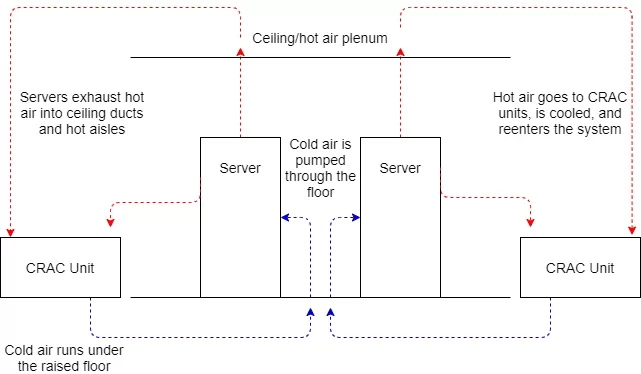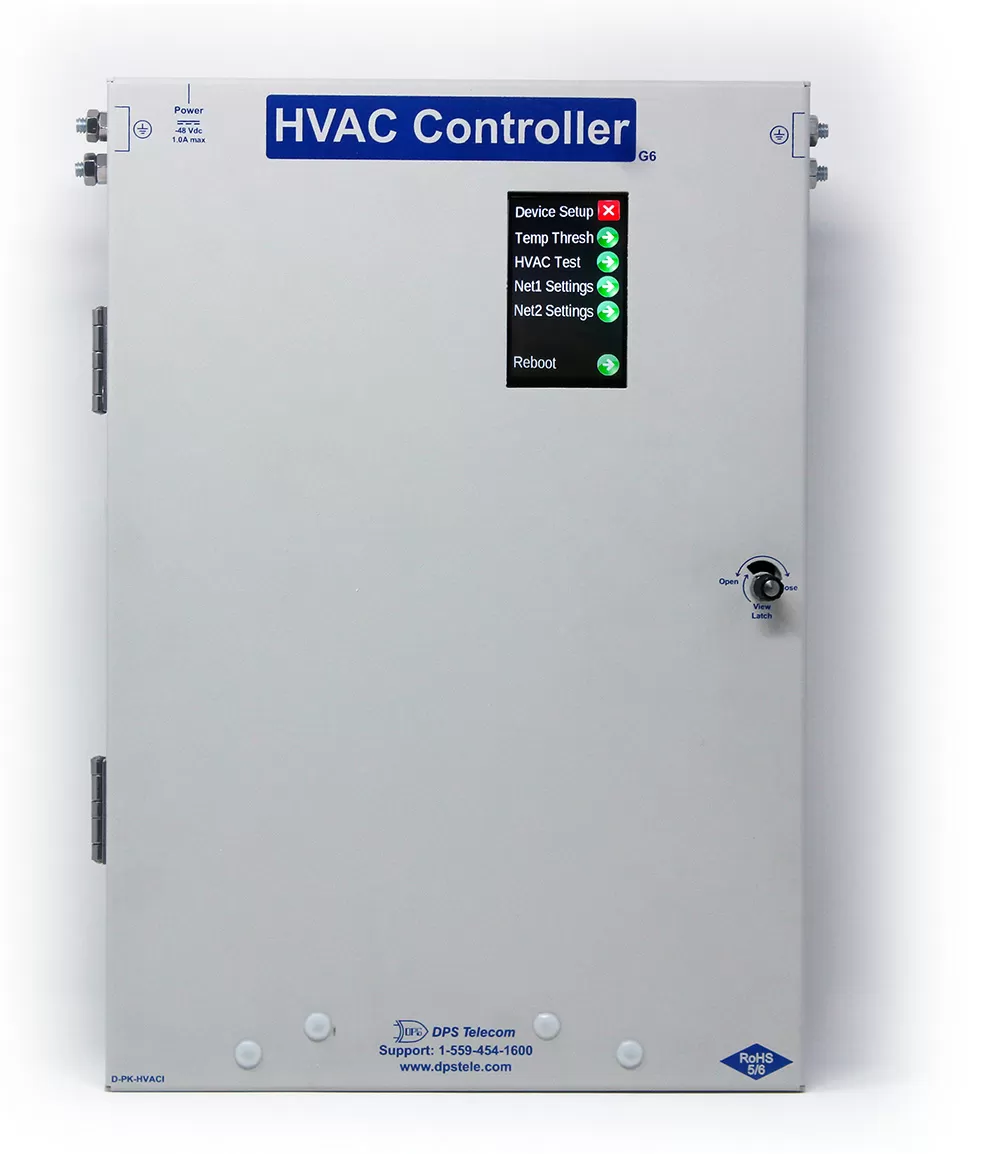Check out our White Paper Series!
A complete library of helpful advice and survival guides for every aspect of system monitoring and control.
1-800-693-0351
Have a specific question? Ask our team of expert engineers and get a specific answer!
Sign up for the next DPS Factory Training!

Whether you're new to our equipment or you've used it for years, DPS factory training is the best way to get more from your monitoring.
Reserve Your Seat TodayComputer systems have never been more critical. Now more than ever, the world runs on a digital infrastructure backbone.
Computer Room Air Conditioning (CRAC) is a vital component of this digital infrastructure.
CRAC units are crucial in the seamless operation of data centers, server rooms, and IT environments.
Remember: CRAC units are not your typical air conditioners. They're meticulously designed to keep your computer systems running smoothly. This mitigates the risk of system failures and prolonged downtime.
CRAC units possess distinct features that set them apart from conventional residential or commercial air conditioning systems. Most notably, they have precision cooling capabilities. They maintain a consistent temperature and humidity level that is essential for the optimal operation of computer systems. These conditions are typically beyond the scope of standard air conditioners.
CRAC units operate continuously, ensuring uninterrupted cooling air distribution. This prevents heat-induced damage to sensitive computer equipment. They also incorporate advanced monitoring and control systems, enabling real-time adjustments to environmental conditions within the server room. CRAC units are usually configured for redundancy, meaning that even if one unit fails, others can take over to maintain the necessary cooling. This level of dependability and precision is critical in IT environments, where even a small fluctuation in temperature or humidity can lead to significant issues.
But how exactly do CRACs work? And what are the benefits of installing CRACs? Let's take a look.

CRAC units function based on a strategic layout often referred to as the "hot aisle/cold aisle" plan. In this configuration, server racks are arranged in alternating rows, with cold air intakes facing one way (cold aisle) and hot air exhausts facing the other (hot aisle). The CRAC units draw in hot air from the hot aisle, cool it down, and then distribute it back into the cold aisle. This precise cooling method ensures that the servers always have a supply of cold air and that the hot air produced by the servers is promptly removed, maintaining an optimal operating environment.
CRACs are designed to meet specific standards set by the government. They need to be powerful and efficient enough to maintain a consistent, controlled temperature.
In most cases, CRACs are required in data centers and server rooms that are at risk of reaching harsh temperatures and harmful humidity levels.
For instance, the U.S. Department of Energy requires server rooms to maintain a temperature range between 53 and 78 degrees Fahrenheit. The U.S. Department of Energy also requires that relative humidity levels are monitored and kept within 35-50%.
Regulatory bodies like ASHRAE (American Society of Heating, Refrigerating, and Air-Conditioning Engineers) have guidelines for environmental conditions in data centers. Using CRAC units helps organizations meet these standards, thereby maintaining compliance and avoiding potential penalties.
Not all computer systems are designed for use in uncontrolled cabinets. Most standard IT equipment comes with a standard operating temperature rating, which can vary from model to model. However, with most equipment, the operating temperature range is fairly limited, usually between 20-25 degrees Celsius (68-77 degrees Fahrenheit).
Computer systems generate significant amounts of heat during operation. Failure to adequately manage this heat can lead to overheating and subsequent hardware failure.
Left unchecked, this hot air can push temperatures outside the acceptable operating range for computer systems.
Moreover, CRAC units also maintain appropriate humidity levels. Extremely high or low humidity can pose a threat to sensitive equipment. Too much moisture can lead to condensation and corrosion, while too little can generate static electricity, both harmful to electronic components.
Without CRACs, the risk of hardware failure due to overheating, extreme humidity, or static electricity increases significantly.
A system failure can lead to data loss, decreased productivity, and, most importantly, customer complaints - every business's nightmare.
By maintaining the optimal environment, CRAC units help prevent heat-induced system failures. your critical services remain available round the clock.
CRAC units also reduce the need for reactive repair and maintenance. This means fewer outages, increased efficiency, and - ultimately - improved customer satisfaction.
Modern CRAC units are designed to be energy-efficient. By precisely controlling the air circulation in response to the changing conditions in the computer room, they reduce energy consumption. This not only results in cost savings but also lowers the carbon footprint.
 The HVAC Controller from DPS Telecom is a cost-effective solution to monitor and control your HVAC units.
The HVAC Controller from DPS Telecom is a cost-effective solution to monitor and control your HVAC units.As one example, the HVAC Controller from DPS Telecom is designed to maximize energy efficiency in computer systems. It gives you the ability to remotely control your cooling settings.
To further optimize energy savings, the controller also features lead-lag control, which enables it to switch between two cooling systems. The primary HVAC will run by default, and a secondary unit will take over after a set amount of time (or if the primary stops working).
This type of smart system leads to more efficient use of energy, which also lowers your overall cost of cooling. It also helps reduce the carbon footprint (great for your PR team!) and can be integrated into existing HVAC systems.
Consistent operating conditions help prolong the life of computer equipment. Fluctuations in temperature and humidity can lead to repeated expansion and contraction of components, accelerating wear and tear. With a CRAC unit in place, you can protect your investment by extending the life expectancy of your critical hardware.
Don't forget to strike a good balance between excessive equipment wear and excessive cooling costs. Most computer equipment can run just fine at temperatures that might make you sweat. For unmanned facilities, you should set the cooling ranges to suit the equipment - not the rare human visitor!
The Comfort Button on the DPS Telecom HVAC Controller was created just for the occasion that someone does visit the site.
The Comfort Button feature allows for quick, easy temperature adjustment to a human-comfort range. When you arrive at the site, you just press the button to get an instant change to more comfortable cooling settings. This is perfect for those rare occasions when personnel need to access the computer room.
The best part is, it times out automatically after 1 hour, reverting back to a temperature range suited to the equipment. I once heard from a client in Alaska that had to devote an entire workday to returning to a site 4 hours from the central office... just to adjust a thermostat knob.
CRAC units form a critical layer of protection in any data center or computer room. They protect your business by ensuring optimal performance and longevity of critical infrastructure. They represent your essential investment that safeguards your operations, helps maintain your business continuity, and ultimately supports the satisfaction of your customers.
By understanding the role of CRAC units and taking steps to ensure they are properly maintained, you can enjoy a safe and reliable IT environment.
CRAC units are an important element of any data center or computer room setup, offering several key benefits. From preventing system failures to improving energy efficiency and extending equipment lifespans, CRACs serve many critical functions.
The key takeaway here is this: if you don't have CRACs in place now - or your existing ones are outdated - then it's time to get your budget together and start shopping for available options from vendors.
There are plenty of CRAC options on the market from a wide range of manufacturers. Be sure to do your research and select dependable units that offer the best value for money. Go with an established company with over 38 years of experience in the industry. Free tech support and the option for customization are also qualities you might want to look for in a provider for your CRAC needs.
At DPS Telecom, we can point you in the right direction for monitoring and controlling the temperature at your remote sites. For remote monitoring and control of CRAC systems, the HVAC Controller allows you to easily monitor and control the cooling of your remote computer equipment. This gives you greater flexibility in how you manage your environment.
At DPS Telecom, we understand the crucial role that CRAC units play in your IT infrastructure. We design our solutions to deliver reliability and peace of mind.
To learn more about how we can help protect your critical infrastructure, please simply call our Engineering team. Tell us what you're trying to accomplish.
To get started, just call 1-800-693-0351 or email sales@dpstele.com

Haley Zeigler
Haley is a Technical Marketing Writer at DPS Telecom. She works closely alongside the Sales and Marketing teams, as well as DPS engineers, resulting in a broad understanding of DPS products, clients, and the network monitoring industry.